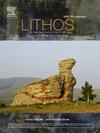The old central igneous complexes of Sal, Boa Vista and Maio islands: Implications for 17 Ma of isotopic evolution of the Cape Verde archipelago
IF 2.9
2区 地球科学
Q2 GEOCHEMISTRY & GEOPHYSICS
引用次数: 0
Abstract
The central igneous complexes of the easternmost islands (Sal, Boa Vista and Maio) preserve some of the most ancient outcropping rocks of the Cape Verde (CV) archipelago. These Early to Middle Miocene (about 25 to 12 Ma) complexes show marked isotopic differences between mafic rocks from the northern (Sal and Boa Vista) and the southern Maio Island, the latter showing lower 143Nd/144Nd, 206Pb/204Pb, 207Pb/204Pb, and higher 87Sr/86Sr ratios. The main mantle plume composition beneath Cape Verde is here considered to be dominated by the FOZO component. Our data supports previous models suggesting the incorporation to plume components of minor DMM mantle sources in the northern CV island alignment, whereas mixing with the EM1 pole is prevalent on the southern CV islands. These isotopic differences are evident since the early stages of Cape Verde magmatism. The Late Miocene to Holocene time period (7 to 1.7 Ma) is characterized by the irruption of silica-undersaturated and carbonatite magmas with a relatively homogeneous isotopic composition and highly radiogenic Pb signatures (206Pb/204Pb up to 20.6 in carbonatitic rocks and 20.2 in silicate rocks) throughout most of the Cape Verde archipelago. During this transitional stage, the input of this new HIMU mantle component overprinted the previous mixing of the main FOZO plume component with shallow mantle members (DMM, EM1) of minor contribution.
求助全文
约1分钟内获得全文
求助全文
来源期刊

Lithos
地学-地球化学与地球物理
CiteScore
6.80
自引率
11.40%
发文量
286
审稿时长
3.5 months
期刊介绍:
Lithos publishes original research papers on the petrology, geochemistry and petrogenesis of igneous and metamorphic rocks. Papers on mineralogy/mineral physics related to petrology and petrogenetic problems are also welcomed.
 求助内容:
求助内容: 应助结果提醒方式:
应助结果提醒方式:


